parking sensors TOYOTA PRIUS PRIME 2023 Owners Manual
[x] Cancel search | Manufacturer: TOYOTA, Model Year: 2023, Model line: PRIUS PRIME, Model: TOYOTA PRIUS PRIME 2023Pages: 680, PDF Size: 14.97 MB
Page 197 of 680
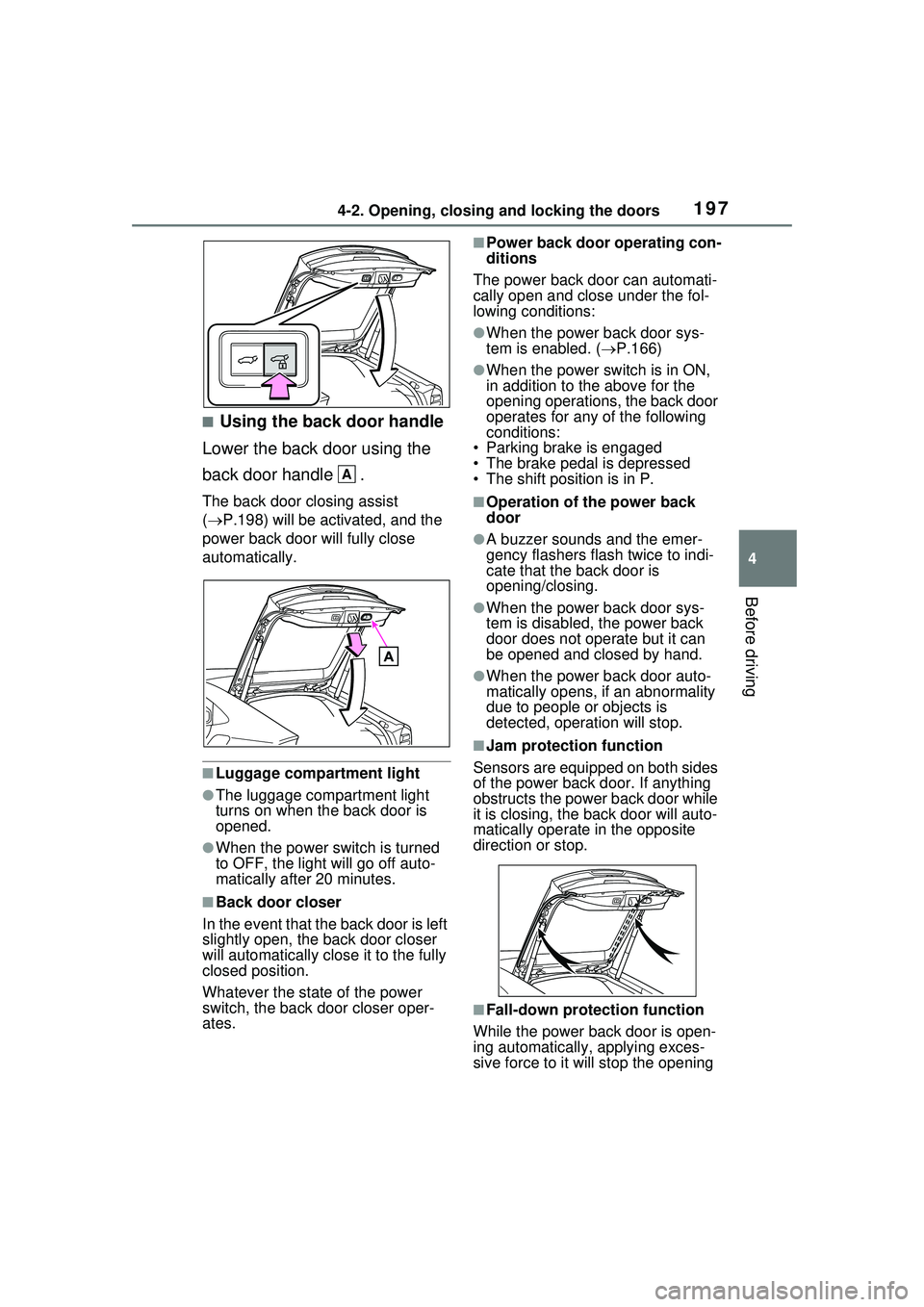
1974-2. Opening, closing and locking the doors
4
Before driving
■Using the back door handle
Lower the back door using the
back door handle .
The back door closing assist
( P.198) will be activated, and the
power back door will fully close
automatically.
■Luggage compartment light
●The luggage compartment light
turns on when the back door is
opened.
●When the power switch is turned
to OFF, the light will go off auto-
matically after 20 minutes.
■Back door closer
In the event that the back door is left
slightly open, the back door closer
will automatically close it to the fully
closed position.
Whatever the stat e of the power
switch, the back door closer oper-
ates.
■Power back door operating con-
ditions
The power back door can automati-
cally open and close under the fol-
lowing conditions:
●When the power back door sys-
tem is enabled. ( P.166)
●When the power switch is in ON,
in addition to the above for the
opening operations, the back door
operates for any of the following
conditions:
• Parking brake is engaged
• The brake pedal is depressed
• The shift position is in P.
■Operation of the power back
door
●A buzzer sounds and the emer-
gency flashers flash twice to indi-
cate that the back door is
opening/closing.
●When the power back door sys-
tem is disabled, the power back
door does not operate but it can
be opened and closed by hand.
●When the power back door auto-
matically opens, if an abnormality
due to people or objects is
detected, operation will stop.
■Jam protection function
Sensors are equipped on both sides
of the power back door. If anything
obstructs the power back door while
it is closing, th e back door will auto-
matically operate in the opposite
direction or stop.
■Fall-down protection function
While the power back door is open-
ing automatically, applying exces-
sive force to it will stop the opening
A
Page 348 of 680
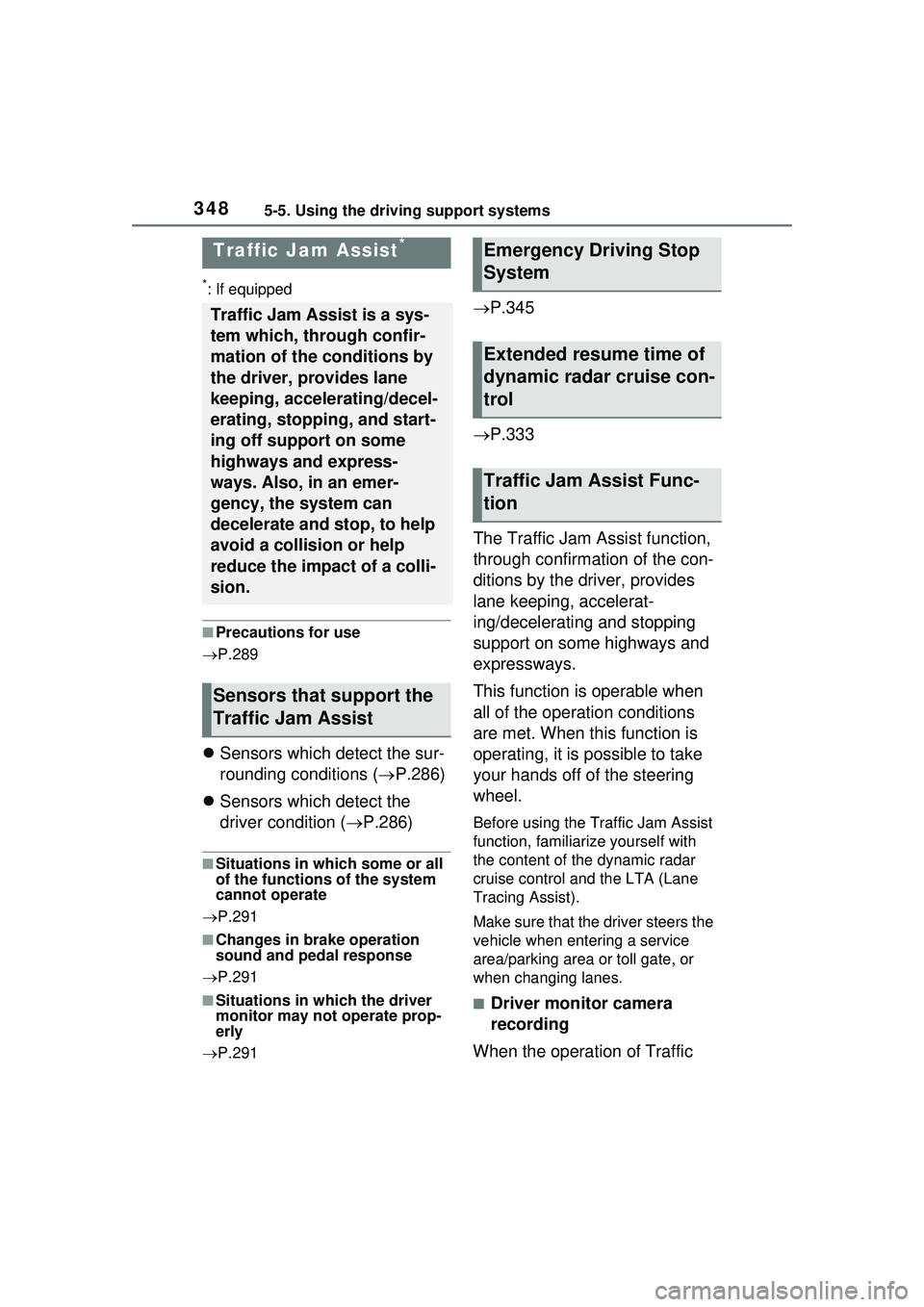
3485-5. Using the driving support systems
*: If equipped
■Precautions for use
P.289
Sensors which detect the sur-
rounding conditions ( P.286)
Sensors which detect the
driver condition ( P.286)
■Situations in which some or all
of the functions of the system
cannot operate
P.291
■Changes in brake operation
sound and pedal response
P.291
■Situations in which the driver
monitor may not operate prop-
erly
P.291
P.345
P.333
The Traffic Jam Assist function,
through confirmation of the con-
ditions by the driver, provides
lane keeping, accelerat-
ing/decelerating and stopping
support on some highways and
expressways.
This function is operable when
all of the operation conditions
are met. When this function is
operating, it is possible to take
your hands off of the steering
wheel.
Before using the Traffic Jam Assist
function, familiari ze yourself with
the content of the dynamic radar
cruise control and the LTA (Lane
Tracing Assist).
Make sure that the driver steers the
vehicle when entering a service
area/parking area or toll gate, or
when changing lanes.
■Driver monitor camera
recording
When the operation of Traffic
Traffic Jam Assist*
Traffic Jam Assist is a sys-
tem which, through confir-
mation of the conditions by
the driver, provides lane
keeping, accelerating/decel-
erating, stopping, and start-
ing off support on some
highways and express-
ways. Also, in an emer-
gency, the system can
decelerate and stop, to help
avoid a collision or help
reduce the impact of a colli-
sion.
Sensors that support the
Traffic Jam Assist
Emergency Driving Stop
System
Extended resume time of
dynamic radar cruise con-
trol
Traffic Jam Assist Func-
tion
Page 363 of 680
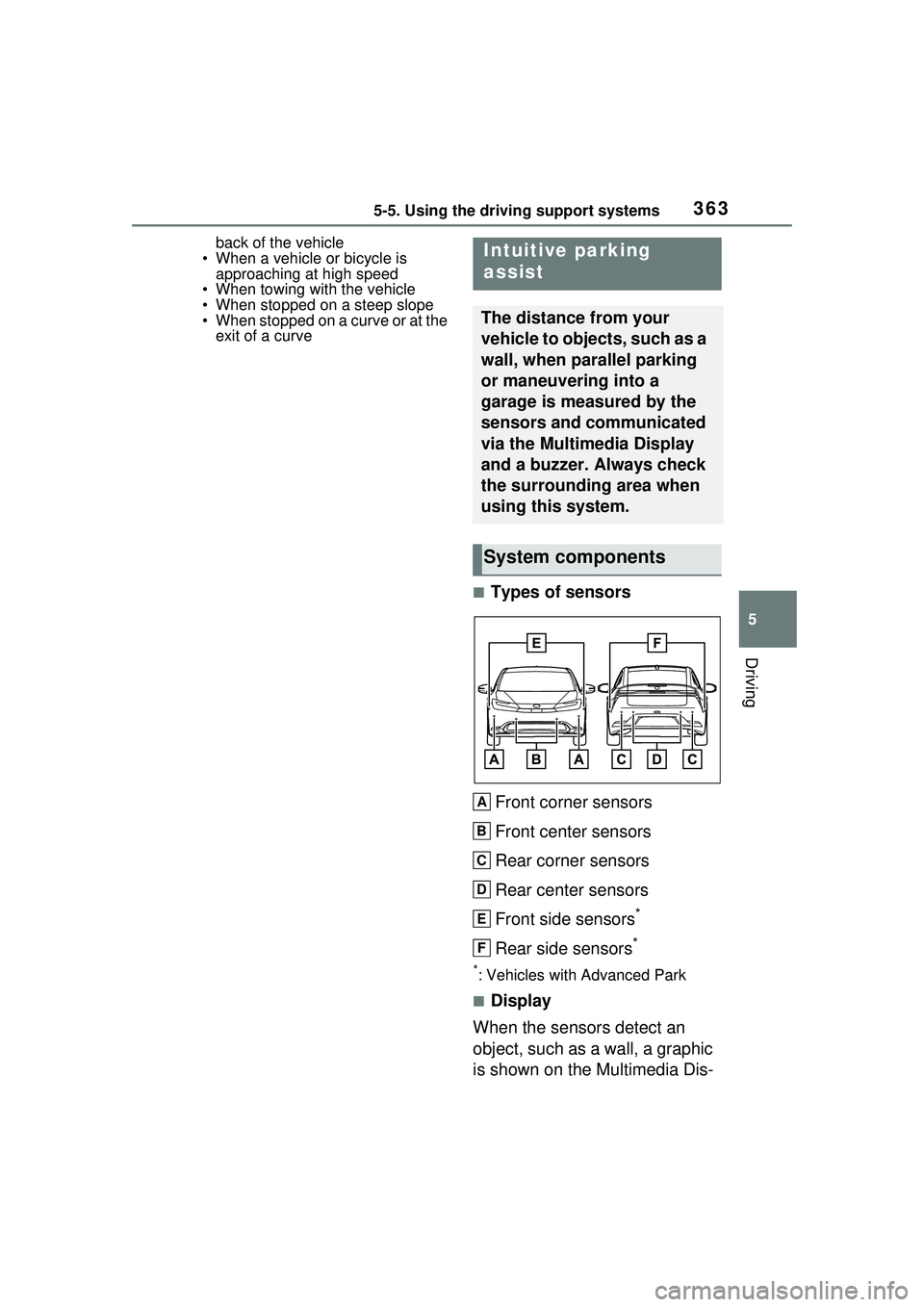
3635-5. Using the driving support systems
5
Driving
back of the vehicle
• When a vehicle or bicycle is approaching at high speed
• When towing with the vehicle
• When stopped on a steep slope
• When stopped on a curve or at the exit of a curve
■Types of sensors
Front corner sensors
Front center sensors
Rear corner sensors
Rear center sensors
Front side sensors
*
Rear side sensors*
*: Vehicles with Advanced Park
■Display
When the sensors detect an
object, such as a wall, a graphic
is shown on the Multimedia Dis-
Intuitive parking
assist
The distance from your
vehicle to objects, such as a
wall, when parallel parking
or maneuvering into a
garage is measured by the
sensors and communicated
via the Multimedia Display
and a buzzer. Always check
the surrounding area when
using this system.
System components
A
B
C
D
E
F
Page 364 of 680
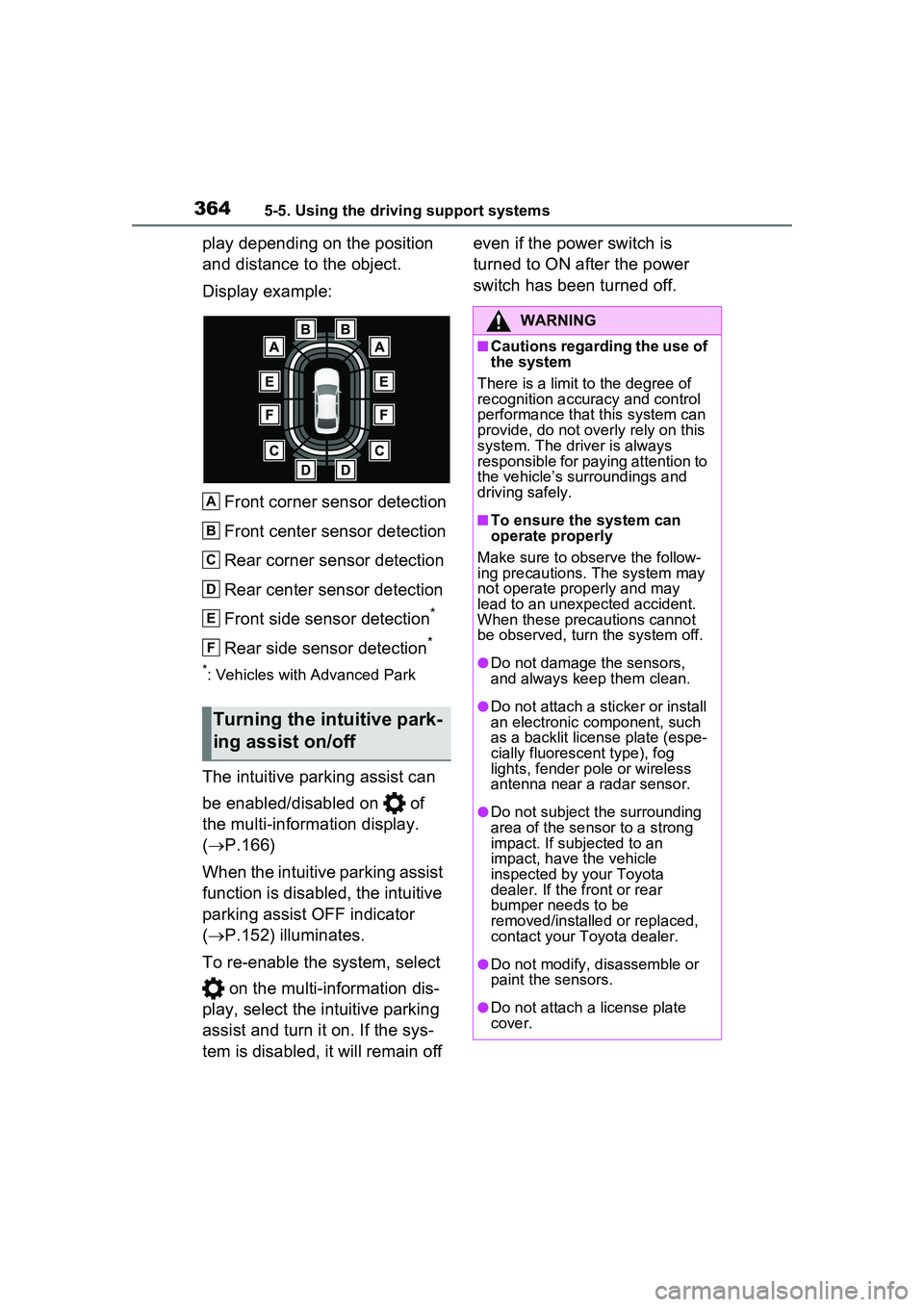
3645-5. Using the driving support systems
play depending on the position
and distance to the object.
Display example:Front corner sensor detection
Front center sensor detection
Rear corner sensor detection
Rear center sensor detection
Front side sensor detection
*
Rear side sensor detection*
*: Vehicles with Advanced Park
The intuitive parking assist can
be enabled/disabled on of
the multi-information display.
( P.166)
When the intuitive parking assist
function is disabled, the intuitive
parking assist OFF indicator
( P.152) illuminates.
To re-enable the system, select on the multi-information dis-
play, select the intuitive parking
assist and turn it on. If the sys-
tem is disabled, it will remain off even if the power switch is
turned to ON after the power
switch has been turned off.
Turning the intuitive park-
ing assist on/off
A
B
C
D
E
F
WARNING
■Cautions regarding the use of
the system
There is a limit to the degree of
recognition accuracy and control
performance that this system can
provide, do not overly rely on this
system. The driver is always
responsible for paying attention to
the vehicle’s surroundings and
driving safely.
■To ensure the system can
operate properly
Make sure to observe the follow-
ing precautions. The system may
not operate properly and may
lead to an unexpected accident.
When these precautions cannot
be observed, turn the system off.
●Do not damage the sensors,
and always keep them clean.
●Do not attach a st icker or install
an electronic component, such
as a backlit license plate (espe-
cially fluorescent type), fog
lights, fender pole or wireless
antenna near a radar sensor.
●Do not subject the surrounding
area of the sensor to a strong
impact. If subjected to an
impact, have the vehicle
inspected by your Toyota
dealer. If the front or rear
bumper needs to be
removed/installed or replaced,
contact your Toyota dealer.
●Do not modify, disassemble or
paint the sensors.
●Do not attach a license plate
cover.
Page 365 of 680
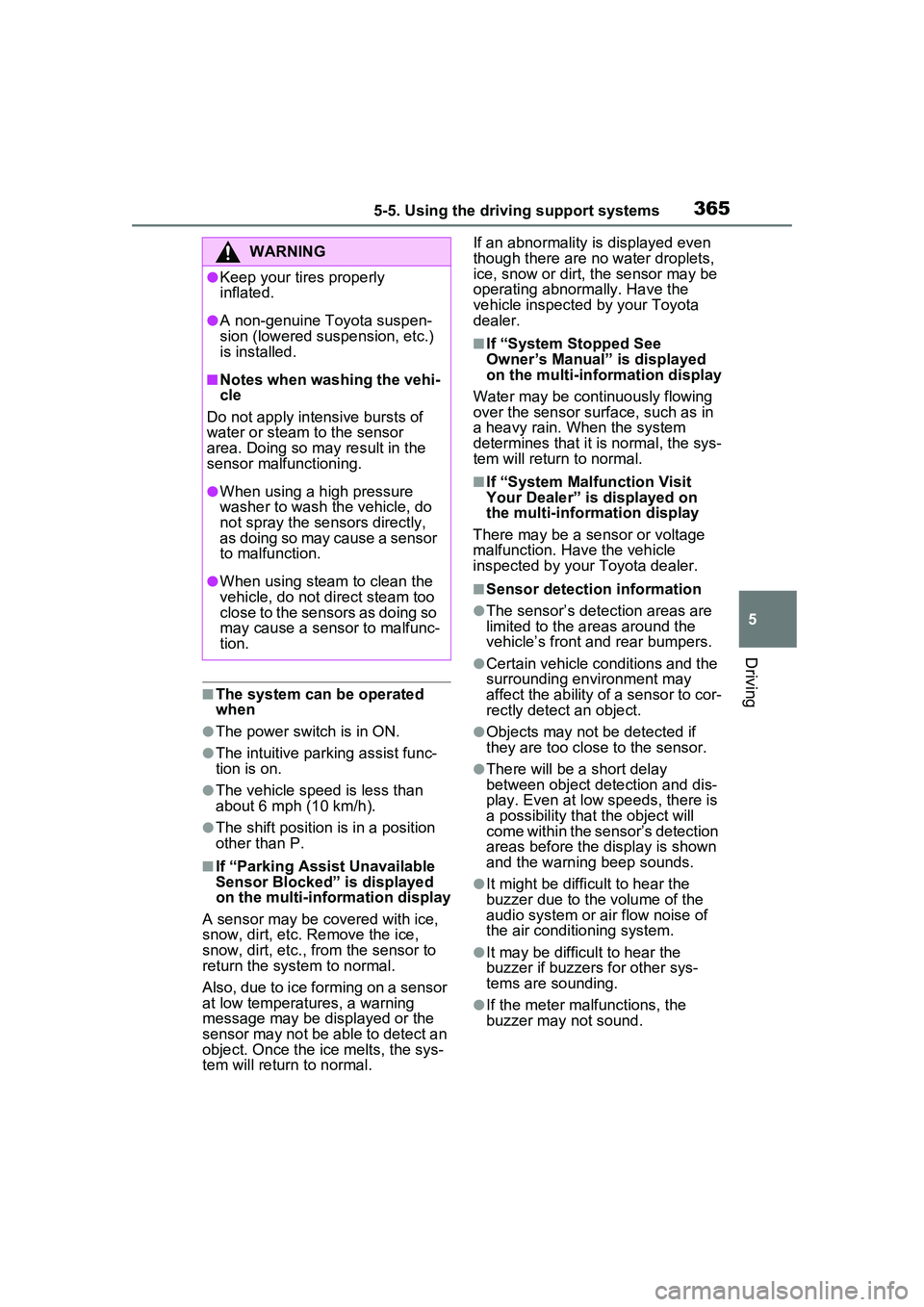
3655-5. Using the driving support systems
5
Driving
■The system can be operated
when
●The power switch is in ON.
●The intuitive parking assist func-
tion is on.
●The vehicle speed is less than
about 6 mph (10 km/h).
●The shift position is in a position
other than P.
■If “Parking Assist Unavailable
Sensor Blocked” is displayed
on the multi-information display
A sensor may be covered with ice,
snow, dirt, etc. Remove the ice,
snow, dirt, etc., from the sensor to
return the system to normal.
Also, due to ice forming on a sensor
at low temperatures, a warning
message may be displayed or the
sensor may not be able to detect an
object. Once the ice melts, the sys-
tem will return to normal. If an abnormality is displayed even
though there are no water droplets,
ice, snow or dirt, the sensor may be
operating abnormally. Have the
vehicle inspected by your Toyota
dealer.
■If “System Stopped See
Owner’s Manual” is displayed
on the multi-information display
Water may be continuously flowing
over the sensor surf ace, such as in
a heavy rain. When the system
determines that it is normal, the sys-
tem will return to normal.
■If “System Malfunction Visit
Your Dealer” is displayed on
the multi-info rmation display
There may be a sensor or voltage
malfunction. Have the vehicle
inspected by your Toyota dealer.
■Sensor detection information
●The sensor’s detection areas are
limited to the areas around the
vehicle’s front and rear bumpers.
●Certain vehicle conditions and the
surrounding environment may
affect the ability of a sensor to cor-
rectly detect an object.
●Objects may not be detected if
they are too close to the sensor.
●There will be a short delay
between object detection and dis-
play. Even at low speeds, there is
a possibility that the object will
come within the sensor’s detection
areas before the display is shown
and the warning beep sounds.
●It might be difficult to hear the
buzzer due to the volume of the
audio system or air flow noise of
the air conditioning system.
●It may be difficult to hear the
buzzer if buzzers for other sys-
tems are sounding.
●If the meter malfunctions, the
buzzer may not sound.
WARNING
●Keep your tires properly
inflated.
●A non-genuine Toyota suspen-
sion (lowered suspension, etc.)
is installed.
■Notes when washing the vehi-
cle
Do not apply intensive bursts of
water or steam to the sensor
area. Doing so ma y result in the
sensor malfunctioning.
●When using a high pressure
washer to wash the vehicle, do
not spray the sensors directly,
as doing so may cause a sensor
to malfunction.
●When using steam to clean the
vehicle, do not direct steam too
close to the sensors as doing so
may cause a sensor to malfunc-
tion.
Page 367 of 680
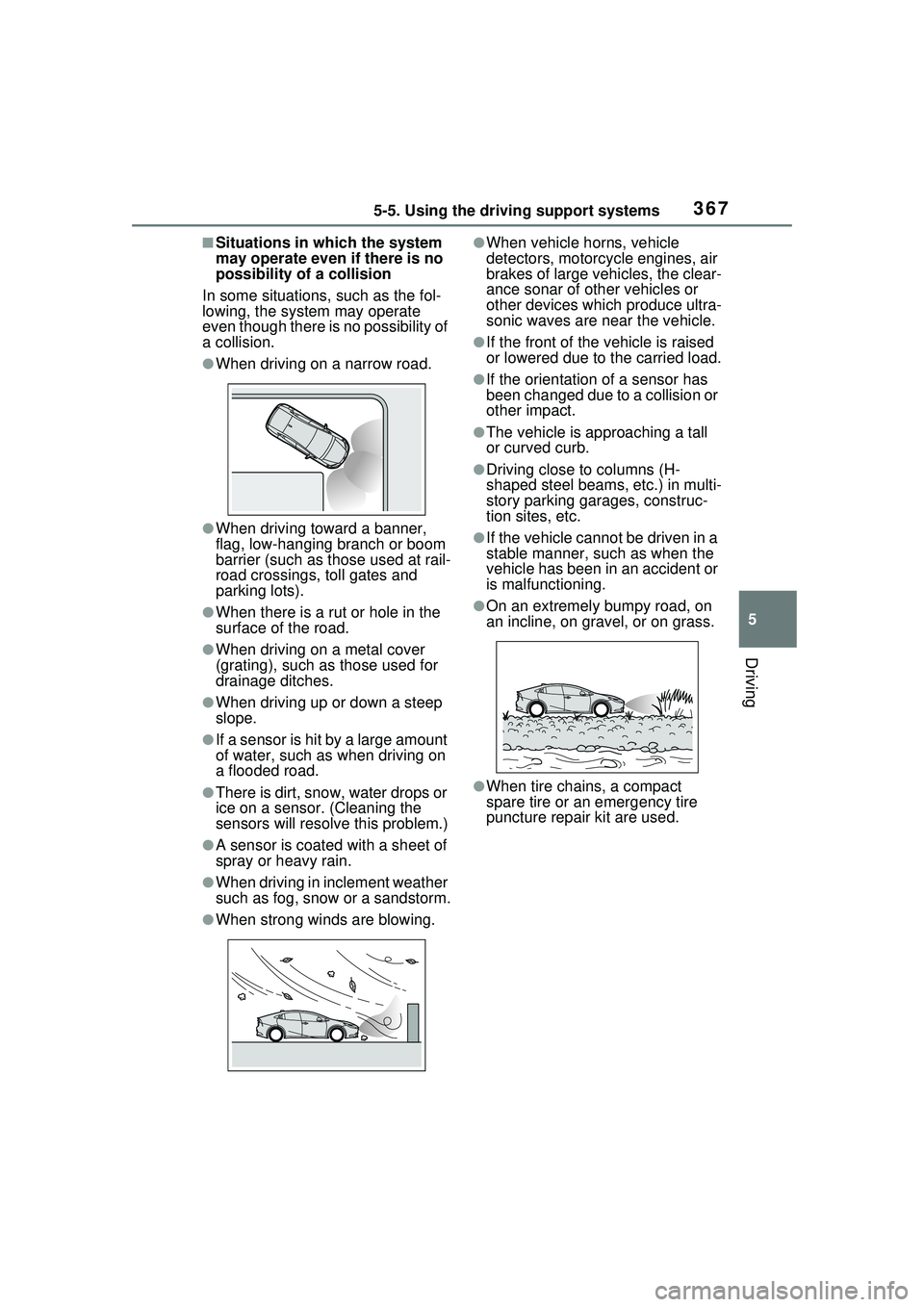
3675-5. Using the driving support systems
5
Driving
■Situations in which the system
may operate even if there is no
possibility of a collision
In some situations, such as the fol-
lowing, the system may operate
even though there is no possibility of
a collision.
●When driving on a narrow road.
●When driving toward a banner,
flag, low-hanging branch or boom
barrier (such as those used at rail-
road crossings, toll gates and
parking lots).
●When there is a rut or hole in the
surface of the road.
●When driving on a metal cover
(grating), such as those used for
drainage ditches.
●When driving up or down a steep
slope.
●If a sensor is hit by a large amount
of water, such as when driving on
a flooded road.
●There is dirt, snow, water drops or
ice on a sensor. (Cleaning the
sensors will resolve this problem.)
●A sensor is coated with a sheet of
spray or heavy rain.
●When driving in inclement weather
such as fog, snow or a sandstorm.
●When strong winds are blowing.
●When vehicle horns, vehicle
detectors, motorcycle engines, air
brakes of large vehicles, the clear-
ance sonar of other vehicles or
other devices which produce ultra-
sonic waves are near the vehicle.
●If the front of the vehicle is raised
or lowered due to the carried load.
●If the orientation of a sensor has
been changed due to a collision or
other impact.
●The vehicle is approaching a tall
or curved curb.
●Driving close to columns (H-
shaped steel beams, etc.) in multi-
story parking garages, construc-
tion sites, etc.
●If the vehicle cannot be driven in a
stable manner, such as when the
vehicle has been in an accident or
is malfunctioning.
●On an extremely bumpy road, on
an incline, on gravel, or on grass.
●When tire chains, a compact
spare tire or an emergency tire
puncture repair kit are used.
Page 370 of 680
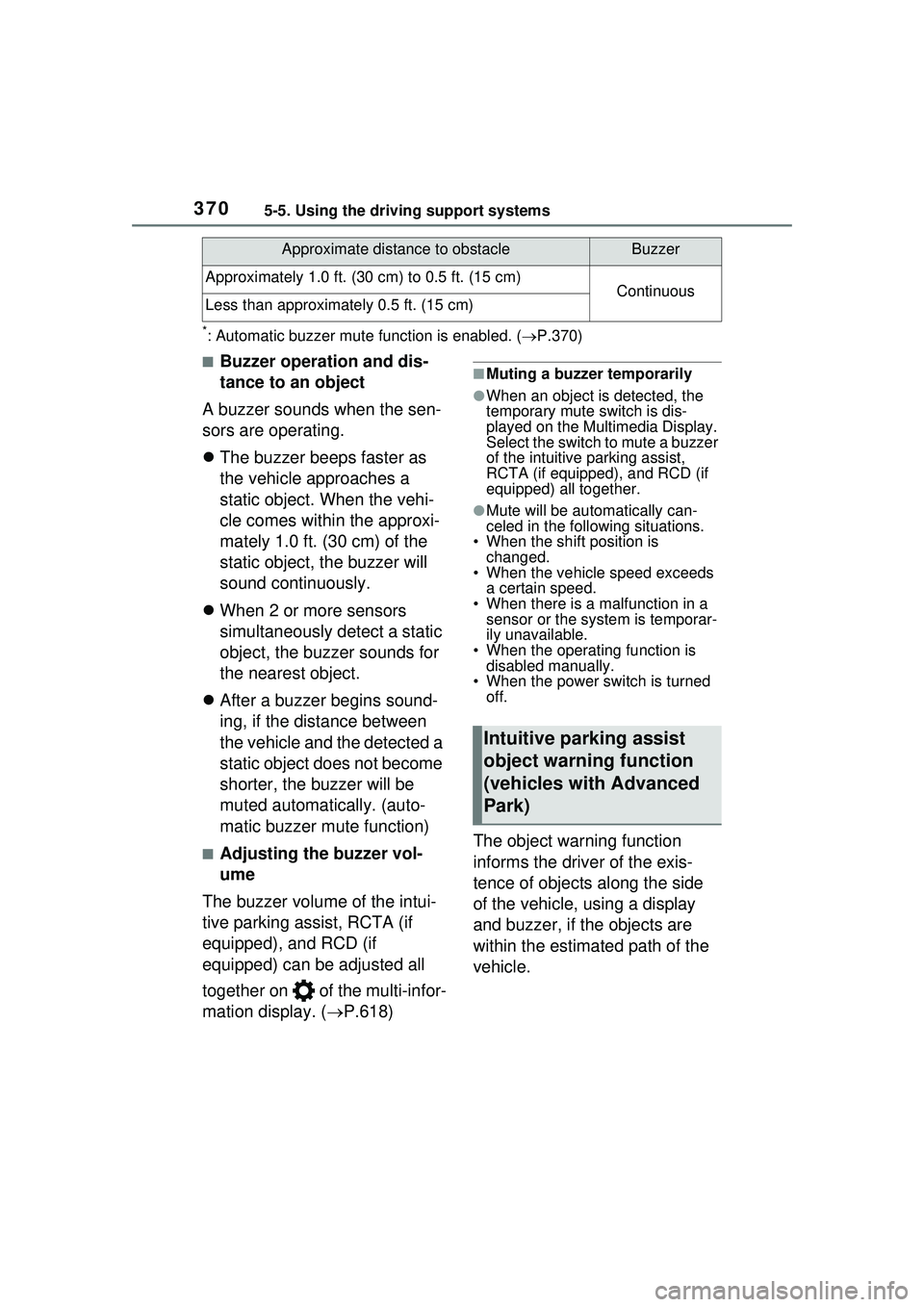
3705-5. Using the driving support systems
*: Automatic buzzer mute function is enabled. (P.370)
■Buzzer operation and dis-
tance to an object
A buzzer sounds when the sen-
sors are operating.
The buzzer beeps faster as
the vehicle approaches a
static object. When the vehi-
cle comes within the approxi-
mately 1.0 ft. (30 cm) of the
static object, the buzzer will
sound continuously.
When 2 or more sensors
simultaneously detect a static
object, the buzzer sounds for
the nearest object.
After a buzzer begins sound-
ing, if the distance between
the vehicle and the detected a
static object does not become
shorter, the buzzer will be
muted automatically. (auto-
matic buzzer mute function)
■Adjusting the buzzer vol-
ume
The buzzer volume of the intui-
tive parking assist, RCTA (if
equipped), and RCD (if
equipped) can be adjusted all
together on of the multi-infor-
mation display. ( P.618)
■Muting a buzzer temporarily
●When an object is detected, the
temporary mute switch is dis-
played on the Multimedia Display.
Select the switch to mute a buzzer
of the intuitive parking assist,
RCTA (if equipped), and RCD (if
equipped) all together.
●Mute will be automatically can-
celed in the following situations.
• When the shift position is
changed.
• When the vehicle speed exceeds a certain speed.
• When there is a malfunction in a sensor or the system is temporar-
ily unavailable.
• When the operating function is disabled manually.
• When the power switch is turned
off.
The object warning function
informs the driver of the exis-
tence of objects along the side
of the vehicle, using a display
and buzzer, if the objects are
within the estimated path of the
vehicle.
Approximately 1.0 ft. (30 cm) to 0.5 ft. (15 cm)ContinuousLess than approximately 0.5 ft. (15 cm)
Approximate distance to obstacleBuzzer
Intuitive parking assist
object warning function
(vehicles with Advanced
Park)
Page 371 of 680
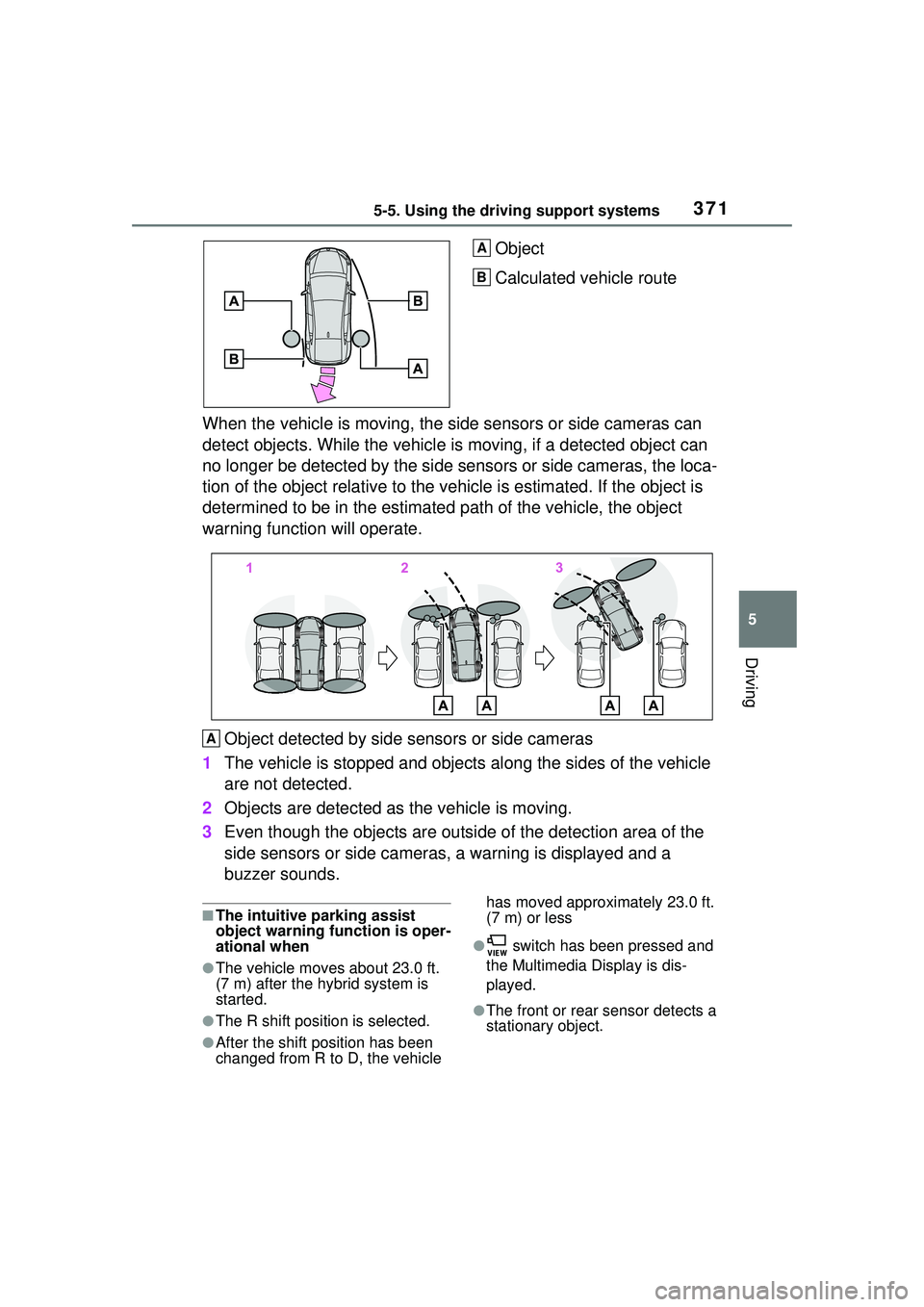
3715-5. Using the driving support systems
5
Driving
Object
Calculated vehicle route
When the vehicle is moving, the side sensors or side cameras can
detect objects. While the vehicle is moving, if a detected object can
no longer be detected by the side sensors or side cameras, the loca-
tion of the object relative to the vehicle is estimated. If the object is
determined to be in the estimated path of the vehicle, the object
warning function will operate.
Object detected by side sensors or side cameras
1 The vehicle is stopped and objects along the sides of the vehicle
are not detected.
2 Objects are detected as the vehicle is moving.
3 Even though the objects are outsi de of the detection area of the
side sensors or side cameras, a warning is displayed and a
buzzer sounds.
■The intuitive parking assist
object warning function is oper-
ational when
●The vehicle moves about 23.0 ft.
(7 m) after the hybrid system is
started.
●The R shift position is selected.
●After the shift position has been
changed from R to D, the vehicle has moved approximately 23.0 ft.
(7 m) or less
● switch has been pressed and
the Multimedia Display is dis-
played.
●The front or rear sensor detects a
stationary object.
A
B
A
Page 375 of 680
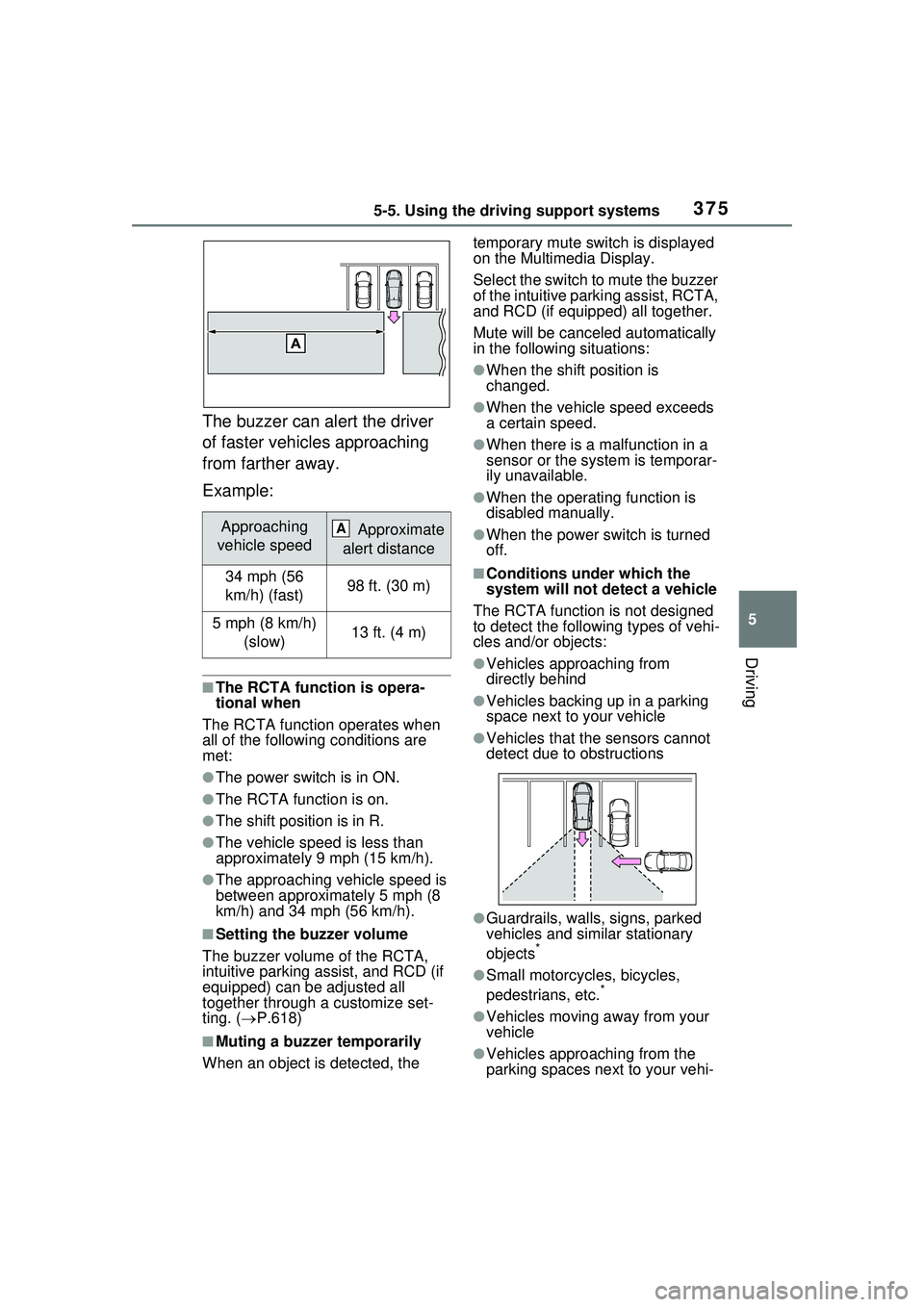
3755-5. Using the driving support systems
5
Driving
The buzzer can alert the driver
of faster vehicles approaching
from farther away.
Example:
■The RCTA function is opera-
tional when
The RCTA function operates when
all of the followin g conditions are
met:
●The power switch is in ON.
●The RCTA function is on.
●The shift position is in R.
●The vehicle speed is less than
approximately 9 mph (15 km/h).
●The approaching vehicle speed is
between approximately 5 mph (8
km/h) and 34 mph (56 km/h).
■Setting the buzzer volume
The buzzer volume of the RCTA,
intuitive parking assist, and RCD (if
equipped) can be adjusted all
together through a customize set-
ting. ( P.618)
■Muting a buzzer temporarily
When an object is detected, the temporary mute switch is displayed
on the Multimedia Display.
Select the switch to
mute the buzzer
of the intuitive parking assist, RCTA,
and RCD (if equipped) all together.
Mute will be canceled automatically
in the following situations:
●When the shift position is
changed.
●When the vehicle speed exceeds
a certain speed.
●When there is a malfunction in a
sensor or the system is temporar-
ily unavailable.
●When the operating function is
disabled manually.
●When the power switch is turned
off.
■Conditions under which the
system will not detect a vehicle
The RCTA function is not designed
to detect the following types of vehi-
cles and/or objects:
●Vehicles approaching from
directly behind
●Vehicles backing up in a parking
space next to your vehicle
●Vehicles that the sensors cannot
detect due to obstructions
●Guardrails, walls, signs, parked
vehicles and similar stationary
objects
*
●Small motorcycles, bicycles,
pedestrians, etc.*
●Vehicles moving away from your
vehicle
●Vehicles approaching from the
parking spaces next to your vehi-
Approaching
vehicle speed Approximate
alert distance
34 mph (56
km/h) (fast)98 ft. (30 m)
5 mph (8 km/h) (slow)13 ft. (4 m)
A
Page 376 of 680
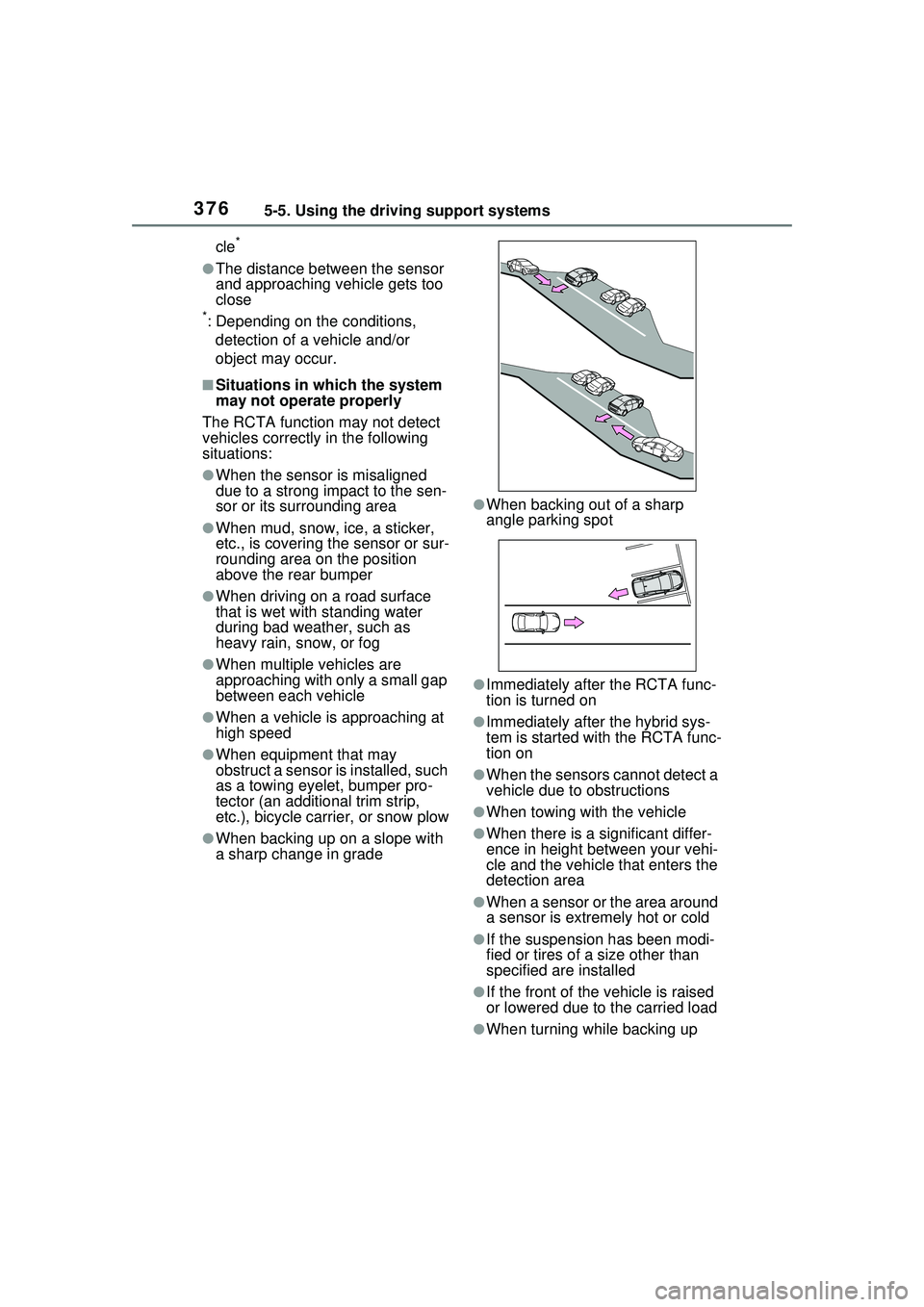
3765-5. Using the driving support systems
cle*
●The distance between the sensor
and approaching vehicle gets too
close
*: Depending on the conditions, detection of a vehicle and/or
object may occur.
■Situations in which the system
may not operate properly
The RCTA function may not detect
vehicles correctly in the following
situations:
●When the sensor is misaligned
due to a strong impact to the sen-
sor or its surrounding area
●When mud, snow, ice, a sticker,
etc., is covering the sensor or sur-
rounding area on the position
above the rear bumper
●When driving on a road surface
that is wet with standing water
during bad weather, such as
heavy rain, snow, or fog
●When multiple vehicles are
approaching with only a small gap
between each vehicle
●When a vehicle is approaching at
high speed
●When equipment that may
obstruct a sensor is installed, such
as a towing eyelet, bumper pro-
tector (an additional trim strip,
etc.), bicycle carrier, or snow plow
●When backing up on a slope with
a sharp change in grade
●When backing out of a sharp
angle parking spot
●Immediately after the RCTA func-
tion is turned on
●Immediately after the hybrid sys-
tem is started with the RCTA func-
tion on
●When the sensors cannot detect a
vehicle due to obstructions
●When towing with the vehicle
●When there is a significant differ-
ence in height between your vehi-
cle and the vehicle that enters the
detection area
●When a sensor or the area around
a sensor is extremely hot or cold
●If the suspension has been modi-
fied or tires of a size other than
specified ar e installed
●If the front of the vehicle is raised
or lowered due to the carried load
●When turning while backing up